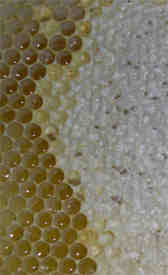Our first honey harvest
Posted by Fiona Nevile in Bees | 0 comments
Capped and uncapped cells in a honey comb
We spent hours looking at the colour of the pollen in the tiny baskets that bees have on their legs. You can match it to the pollen colours on a little colour card that indicates where they have been foraging. A certain tint of dark red pollen signifies horse chestnut trees, for example, . This guide, Pocket Pollen Guide by Stephen Hardy, is available from Northern Bee Books for £1.50 at time of writing. Click here for more details.
In August I prepared for our harvest. I bought pretty hexagonal jars for honey and little boxes for cut comb honey. I also invested in a nifty spring action cutter that enables you to cut the honey comb from the frame and place it in a box with minimum mess.
After a long week, we’d finally cleared most of the bees from the section of the hive that held our cut comb honey (the book said that this would take 24 hours). When it was dark, we pulled on our beesuits, for the seventh time, and crept out to the hive. We took off the roof, and whipped off the super. There was hardly a buzz from the bees hanging out on the front of the hive. Anyway, they should have been in bed.
Wearing his new washable leather beekeeping gloves, Danny proudly carried the super into the kitchen. I held the torch. He did say, as we hurried away from the hive, that the super was surprisingly light.
When honey is ready to be harvested it is capped by the bees. A capped cell in the honeycomb is sealed on both sides with a thin layer of wax. Check out the photo: Uncapped to the left and capped (white) to the right. A capped frame is quite heavy. And a super, filled with capped frames is a hefty lift. If uncapped honey is collected, it quickly starts to ferment. We prised out each frame to examine it but not one was completely capped. We worked in a disappointed silence. Even the dogs, locked in the sitting room, were quiet.
Finally Danny spoke. He’d been reading the book. We had an option and that was to pop the super back on the hive and see whether the bees would cap any more cells by the weekend.
We went out today and inspected each frame in the earmarked super and the two other ones, that we’d put on when the bee were getting restive, to see if any were fully capped. Within a few seconds we realised that stores were so slim that the bees were going to keep most of their honey for the coming winter. We took two frames for ourselves, these had about 60% of capped cells.
Tonight, wielding the honey comb cutter, I will fill a handful of boxes with our mini harvest.
Tomorrow all disappointment will be forgotten when we breakfast on thick toast, heavy with Cottage Smallholder cut comb honey.
Leave a reply




